(Upload on December 14 2020) [ 日本語 | English ]
Mount Usu / Sarobetsu post-mined peatland
From left: Crater basin in 1986 and 2006. Cottongrass / Daylily
HOME > Lecture catalog / Research summary > Glossary > Chemistry > Chemicals
[ プロトコル ]
|
mole number or molar number |
Ionic compounds (イオン化合物)NO2-: nitrite, NO3-: nitrateSO32-: sulfite, SO42-: sulfate, HSO4-: hydrogen sulfate ion (/bisulfate) (bi = H) CO32-: carbonate, HCO3-: hydrogen carbonate (/bicarbonate) PO43-: phosphate, HPO42- :hydrogen, H2PO4-; dihydrogen (di + 2 atoms) ClO-: hypochlorite (less oxygen), ClO2-: chlorite, ClO3-: chlorate, ClO4-: perchlorate (more oxygen) |
|
alkyl groups aryl groups |
Ether (エーテル)R-O-R'__R, R' = alkyl or aryl groups
Alcohol (アルコール)Ethanol (エタノール) Phenol (フェノール)Aldehyde and ketone (アルデヒド/ケトン)Carboxylic acid (カルボン酸)Ester (エステル) |
Redox (oxidation-reduction or oxidoreduction, 酸化還元)Def. oxidation-reduction potential (ORP) (酸化還元電位)= redox potential, or electrode potential on the hydrogen scale (Eh) Redox indicator (酸化還元指示薬)= oxidation-reduction indicatorindicators that undergo a color change at a specific electrode potential fast and reversible color change Ex. KMnO4
• metal complexes of phenanthroline and bipyridine 2, 3, 5-triphenyl tetrazolium chloride (TTC), C19H15ClN4
Also used for checking seed viability
|
Table. Major reducing substances and reduction systems reacted to tetrazolium salts
Electrolysis (電気分解)
Platinum electrode (白金電極) |
|
Saturated straight chain (飽和直鎖状) Saturated branched (飽和分枝状) Saturated chain (飽和環状) (cycloparaffine 飽和環状炭化水素) Unsaturated straight chain (不飽和直鎖状) Unsaturated chain (不飽和環状) |
= carbohydrateClassificationAlkane (アルカン)CnH2n + 2 → IUPAC nomenclature
n Eq. nom. B/Mp AOTP Isomers SSF
1 CH4 Methane -162 /-183 gas 0 CH4
2 C2H6 Ethane -89 /-184 gas 0 CH3-CH3
3 C3H8 Propane -42 /-187 gas 0 CH3-CH2-CH3
4 C4H10 n-butane -0.5/-138 gas 2 CH3-CH2-CH2-CH3
i-butane CH3-CH3-CH-CH3
5 C5H12 n-pentane 36 /-130 liquid 3
iso-pentane
neo-pentane
6 C6H14 n-hexane 69/-95 liquid 5
iso-hexane
…
10 C10H22 liquid 95
14 C14H30 liquid 1858
→ many isomers → limitations of nomenclature |
Eq.: equation, nom.: nomenclature, B/Mp (oC): boiling and melting points, AOTP: at ordinary temperatures and pressures, SSF: shortened structural formula |
Monosaccharide (単糖類)Uronic acids (ウロン酸)Fucose (フコース)C6H12O5 L-rhamanose (6-deoxy-L-mannose)L-fucose (6-deoxy-2-galactose) Pentose (五炭糖) Arabinose
L-phamnose (6-deoxy-L-mannose) L-fucose (6-deoxy-L-galactose) Glucose (グルコース, ブドウ糖)
CHO
glyceraldehyde(basic molecule) |
Starch (デンプン)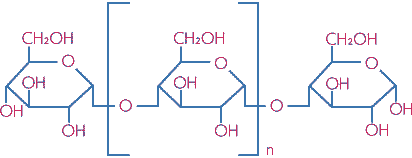 |
|
Succinic acid (コハク酸): HOOC-CH2-CH2-COOH Malic acid (リンゴ酸): HOOC-CH2-CH(OH)-COOH Fumaric acid (フマル酸): HOOC-CH=CH-COOH Oxaloacetate (オキザロ酢酸): HOOC-CH2-CO-COOH Citric acid (クエン酸): C(OH)(CH2COOH)2COOH
|
Pyruvic acid (ピルビン酸)CH3COCOOH
= 2-oxopropanoic acid (2-オキソプロパン酸), IUPAC |
|
Biologically important organic compounds containing amine (-NH2) and carboxylic acid (-COOH) functional groups
Natural amino acids (天然アミノ酸)1) Non-polar amino acid (非極性アミノ酸)R =1) -H: glycine (グリシン, Gly, G) 2) -CH3: alanine (アラニン, Ala, A) 3) -CH2(CH3)-CH·CH3: leusine (ロイシン, Leu, L) 4) -CH(CH3)-CH2·CH3: isoleusine (イソロイシン, Ile, I) 5) -CH2-S-CH3: methionine (メチオニン, Met, M) 6) -CH2- 7) 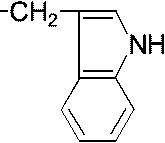 : tryptophane (トリプトファン, Trp, W) : tryptophane (トリプトファン, Trp, W)8) 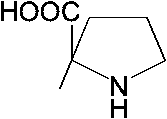 : proline (プロリン, Pro, P) : proline (プロリン, Pro, P)9) -CH(CH3)-CH3: valine (バリン, Val, V) 2) Polar and charge-free amino acids (極性だが電荷のないアミノ酸)10) -CH2OH: serine (セリン, Ser, S)11) -CHOH·CH3: threonine (スレオニン, Thr, T) 12) -CH2SH: cysteine (システィン, Cys, C) 13) -CH2- 14) -CH2CONH2: glutamine (グルタミン, Gln, Q) 15) -CH2CH2CONH2: asparagine (アスパラギン, Asn, N) |
3) Charged amino acids (電荷を持つアミノ酸)i) positively-charged amino acids16) -(CH2)4-NH2: lysine (リジン, Lys, K) 17) 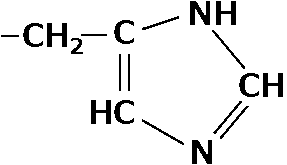 : histidine (ヒスチジン, His, H) : histidine (ヒスチジン, His, H)18) -CH(NH2)-CH-NH-C=NH: arginine (アルギニン, Arg, R) ii) negatively-charged amino acids 19) -CH2COOH: glutaminic acid (グルタミン酸, Glu, E) 20) -CH2CH2COOH: asparatic acid (アスパラギン酸, Asp, D) The proteins are formed by these 20 amino acids D-typed amino acids do not exsist in the nature 4) Non-proteinous amino acids (非タンパク質性アミノ酸)not present in proteins-(CH2)3-NH2: L-ornithine (L-オルニチン, Orn) -(CH2)3-NH(O=C-NH2): L-citrulline (L-シトルリン, Cit) → these two amino acids were discovered in ornithine cycle NH2-CH2-CH2-COOH: β-alanine (β-アラニン)Coenzyme A: a structural component of pantothenic acid (パントテン酸) 21)  hydroxyproline (ヒドロキシプロリン) hydroxyproline (ヒドロキシプロリン)
→ occupying 12% of proteins in collagen 22) -(CH2)2-CH·OH-CH2-NH2: hydroxylisine (ヒドロキシリジン)→ rich in collagen, as well as hydroxyproline → number of essential amino acids (for the structural components of proteins) is 22 when these two amino acids are included |
|
Table. Classification of proteins based on biological functions __• Types and examples ___ function
|
|
|
polus (G. many or much) + phenol = polyhydroxyphenols: large multiples of phenol structural units Phenolic acid (フェノール酸)Rutin (ルチン)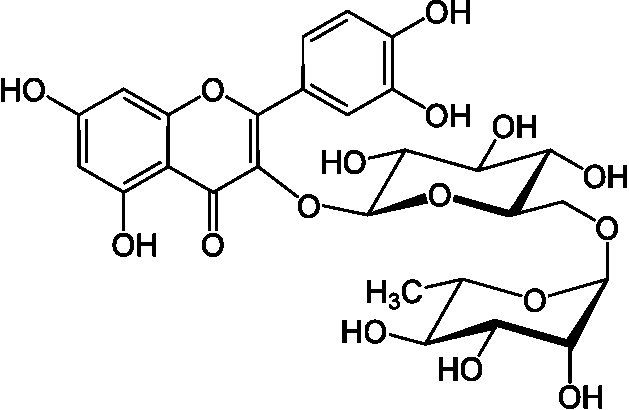
|

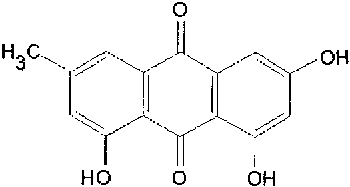 Anthraquinone physcion_____________Anthraquinone edmodin 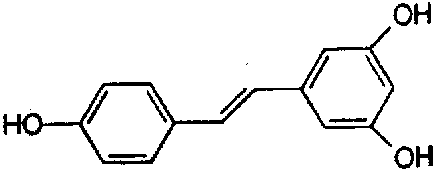 Resveratrol (レスベラトロール): Giant knotweed contains much resveratrol, one of the biologically active molecules. |
Sterol (ステロール)= steroid alcohol
Cholesterol (コレステロール)C27H46O: a sterol (or modified sterol) in lipids
a precursor for the biosynthesis of steroid hormones, bile acid and vitamin D |
Cholesteryl ester (コレステロールエステル), CE |